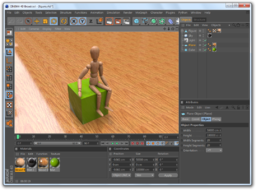- Cinema 4D
-
Maxon CINEMA 4D 

Screenshot of CINEMA 4D Release 12 running under Windows 7Developer(s) MAXON Computer GmbH Stable release R13.029 / September, 2011 Operating system Mac OS X, Microsoft Windows, Linux Type 3D computer graphics License Proprietary Website Maxon CINEMA 4D site CINEMA 4D is a 3D modeling, animation and rendering application developed by MAXON Computer GmbH of Friedrichsdorf, Germany. It is capable of procedural and polygonal/subd modeling, animating, lighting, texturing, rendering, and common features found in 3d modelling applications.
Contents
Overview
The application relies on widely used computer 3D technology which works by creating groups of "points" (known as vertices) who form surfaces when connected. The illusion of three dimensions is created by modeling objects out of multiple surfaces. Still pictures, movies and game environments (among other things) can be created with this technique.
When a scene is finished it is normally rendered. Rendering refers to the act of calculating the scene, the shading, the colors and the textures. After rendering one is able to save the project in many different file formats including high resolution image and video files (such as AVI or QuickTime). Rendering a 3D scene can take anywhere from few seconds to several days depending on the complexity of the scene and the power of the computer. Rendering a movie is especially time-consuming.
CINEMA 4D has its own programming language, C.O.F.F.E.E., to develop platform independent plug-ins. It's also available a free plug-in.
There are three different packages put out by MAXON: the core CINEMA 4D application, the XL-Bundle (including Net Render [3 lic], PyroCluster, Advanced Render, MOCCA and Thinking Particles), and the Studio-Bundle, which includes all modules. CINEMA 4D runs on Windows and Macintosh PC's - a Linux version for commercial studio use is available upon request. Initially, CINEMA 4D was developed for Amiga computers in the early nineties.
MAXON has created a way for all users to be able to 'get into' 3D with their software by pursuing this route. There are also on-line communities such as c4d cafe and CGTalk available to help the neophyt C4Der. Finally, it should be noted that MAXON bundles printed manuals (at extra charge) and tutorials/videos with its software.
Modules
Up until Release 11.5, Cinema 4D had a modular approach to the application, with the ability to expand upon the core application with various modules. This modular approach to Cinema 4D came to an end with Release 12, though the functionality of these modules remains in the various flavors of Cinema 4D (Prime, Broadcast, Visualize, Studio) The old modules were:
- Advanced Render (global illumination/HDRI, caustics, ambient occlusion and sky simulation)
- BodyPaint 3D (direct painting on UVW meshes; now included in the core. In essence Cinema 4D Core/Prime and the BodyPaint 3D products are identical. The only difference between the two is the splash screen that is shown at startup and the default user interface.)
- Dynamics (for simulating soft body and rigid body dynamics)
- Hair (simulates hair, fur, grass, etc.)
- MOCCA (character animation and cloth simulation)
- MoGraph (Motion Graphics procedural modelling and animation toolset)
- NET Render (to render animations over a TCP/IP network in render farms)
- PyroCluster (simulation of smoke and fire effects)
- With CINEMA 4D R10, the module PyroCluster became integrated in the Advanced Render module
- Sketch & Toon (tools for cel shading, cartoons and technical drawings)
- Thinking Particles (enhanced particle system based on nodes)
- Expresso (is not and never has been a module, it is a core functionality)
As of Release 13, Cinema 4D comes in 4 flavors:- Prime (the core application)
- Broadcast (a bundle aimed at motion graphics artists)
- Visualize (aimed at product and architectural visualization artists)
- Studio (the complete package)
For a full comparison of the various flavors of Cinema 4D go to the Maxon Product Comparision page
Additional rendering engines
As of 2007[update], these alternative rendering engines and connections are currently available as plug-ins for CINEMA 4D:
- finalRender stage 2.0 SP4 from Cebas Computer GmbH
- FryRender from RandomControl
- Maxwell Render from Next Limit Technologies
- Pixar Renderman Connection Cineman from MAXON Computer GmbH
- Indigo Renderer, unbiased photorealistic renderer
- Octane Render, unbiased GPU-accelerated renderer
- SunFlow
- V-ray
- mental ray & iray from at² GmbH
Version history
1990 - Christian and Philip Losch enter their ray-tracer into Kickstart magazine's monthly programming contest, and win the competition.
1991 - FastRay (CINEMA 4D's first name) is released for the Amiga.
1993 - CINEMA 4D V1 is released for Amiga.
1994 - Release of CINEMA 4D V2 for Amiga.
1995 - Release of CINEMA 4D V3 for Amiga.
- Plans are made for porting CINEMA 4D to the PC platform.
- New programmer team begins development of a completely new, operating-system-independent architecture.
1996 - CINEMA 4D V4 for Windows, Alpha NT and Macintosh is released.
- The first multi-processor version of CINEMA 4D is made available.
1997 - The development of a production-level version begins, integrating the latest technologies.
- The first production-worthy version is released — CINEMA 4D XL V5.
1998 - CINEMA 4D SE V5 is released.
1999 - CINEMA 4D GO V5 and CINEMA 4D NET are introduced.
2000 - CINEMA 4D XL V6 is released.
- BodyPaint 3D is made available as an integrated version for CINEMA 4D, and as a standalone version for other 3-D packages.
2001 - CINEMA 4D ART is introduced.
- PyroCluster and Dynamics modules are introduced.
- CINEMA 4D XL R7 is shipped worldwide.
- MAXON integrates the shader set Smells like Almonds from bhodiNUT.
2002 - CINEMA 4D R8 is released with a modular system. The new modules are Advanced Render, PyroCluster, MOCCA and Thinking Particles.
2003 - CINEMA 4D R8.5 is released.
- BodyPaint 3D R2 is introduced.
- Sketch and Toon module is introduced.
2004 - CINEMA 4D R9 is released.
2005 - CINEMA 4D R9.5 is released.
- HAIR module is introduced.
2006 - CINEMA 4D R9.6 is released.
- MoGraph module is introduced.
- CINEMA 4D R10 with integrated BodyPaint 3D is released.
2007 - CINEMA 4D becomes the first professional 3-D graphics application released as a Universal Binary for Apple's new Intel-powered Macs (even before Apple Universal Binary versions of its own software are released).
- Service update R10.1 is released in March, in response to bug feedback provided to Maxon by users and testers.
- Service update R10.111 released to address several reported problems, such as stability.
- CINEMA 4D R10.5 is released, and features updates to MOCCA and MoGraph, as well as an optimization of the HAIR module.
2008 - CINEMA 4D R11 released.
- CINEMA 4D supports 64-bit architecture on Apple G5 and Intel-powered Macs.
- A new implementation of Global Illumination (included in the Advanced Render module) offers a higher quality than that of the old version, and much improved animation support.
- Non-Linear Animation has been completely reworked.
- The Renderman support (CINEMAN) is now included in AR.
2009 - CINEMA 4D R11.5 released.
- Introduces MoGraph 2 (which includes MoDynamics [Uses the Bullet Engine], PolyFX, and MoSplines)
- Bucket rendering reduces render times and manages clone instancing and memory management much more efficiently. Anti-Aliasing methods to choose from are Scanline, Ray-Tracing, and Hybrid (which uses both to best optimize quality vs. speed). Also greatly improved Subpolygon Displacement and Area Shadows efficiency and speed using Multi-Threading.
- An enhanced Picture Viewer that will allow a history of renders, RAM previews, and A/B swiping. Also, manages post filtering and Multi-Pass Layers.
- Full 3D support for Apple Motion, and improved support with Adobe After Effects. Also, exports clones and XRefs to Motion and After Effects, as well as the ability to bring in solids for mapping video onto 3D surfaces. It can also export multiple cameras at once.
- Fully compatible with Mac OS X Snow Leopard (10.6) and Windows 7.
- Quicktime for Windows (64 bit) now supported.
- File exchange for FBX 2010.0
- Other new features include a new Camera Shader which will map any camera view onto any surface, improved MoGraph Effectors, and other general improvements and refinements.
2010 - CINEMA 4D R12 released.
- Dynamics has been improved (complex physicengine)
- Renderer works better / faster.
- Menu has been cleaned up.
- Many minor improvements like the Shaders and Materials.
- Linear workflow introduced with correct display in OGL.
- Double precision calculation introduced and true units.
- Support for IES lights and physically correct lighting.
- Integration of Python
- Support of OpenGL 3
- Support for PPC CPUs (G5) dropped.
2011 - CINEMA 4D R13 released.
- New Physical Render engine (More photorealistic: Physical Camera with ISO, f-stop and shutter speed or angle, true depth of field, true motion blurring, lens distortion, vignetting, and chromatic aberration.)
- Stereoscopy. New Stereoscopic Camera and Rendering with real-time display. Supports Anaglyph, Side-by-Side, Interlaced, or Active Shutter mode for 3D Monitors, projectors and glasses.
- New Character tools, allowing the user to set up complex rigs quickly and easily. CMotion Walk Cycle editor; Character Components for TDs to define rig hierarchies, and new Muscle Object & MSkin Deformer.
- Animation refinements. Rotation Order and Gimbaling Rotation Axis to detect and correct gimbal lock. Better timeline markers. Finely tuned F-Curves. Colored animation paths.
- Optimized Modeling workflow. (Enhanced cloning and extrusions; Advanced selection tools; new optimized HyperNURBS weighting algorithm for cleaner topology and sharper but smooth creases; Axis toggle; Auto Tweaking; Easy, intuitive Snapping; Variable Speed Scaling; Better ClothNURBS Extrusion)
- New, accurate Sub-Surface Scattering shader (SSS). Terrain Mask shader. Brick Shader enhancements. Enhanced MoGraph Muti-Shader.
- Improved Interface and Workflow. Enhanced Picture Viewer. All-new External Referencing System for XRefs.
- New Import/Export features (After Effects Integration; FBX Import/Export supports 2010, 2011, and 2012; Multi-Channel OpenEXR; Enhanced Sound Format support including AIF, MP3, and AAC; Collada 1.5; BodyPaint 3D support for Maya UVs)
Use in industry
A number of films and related works have been modeled and rendered in CINEMA 4D, including[1]:
- Beowulf
- The Ship-boys of Bontekoe
- The Golden Compass
- Surf's Up
- We Are the Strange
- Spider-Man 3
- Monster House
- War of the Worlds
- Chronicles of Narnia
- Serenity
- Inception
- Doom
- Prehistoric Park
- Homework
- Van Helsing
- Bernd das Brot
- Generation
- The Polar Express
- King Arthur
- June 17, 1953, State of Emergency
- Open Season[2]
- He Was a Quiet Man
- Surrogates
- Tron: Legacy
- Roger Waters: The Wall Live tour projections (some of them) [3]
See also
References
External links
Motion graphics & Animation editor software Open source 2D3DProprietary Adobe After Effects · Adobe Flash · Anime Studio · Autodesk 3ds Max · Autodesk Maya · Autodesk Softimage · Bryce · Cinema 4D · Dimp Animator · Dynamation · Elastic Reality · Express Animator · Fantavision · Fix8 · Gryphon Software Morph · Houdini · LightWave 3D · MASSIVE · Messiah · Mediator · Motion · Moviestorm · Pivot Stickfigure Animator · Softimage 3D – SWFTools · SWiSH Max · Spider-Man Cartoon Maker · Strata 3D · Stykz · Swift 3D · TISFAT · Toon Boom · Toufee · TVPaint · X-Men Cartoon Maker3D computer graphics software Open source Art of Illusion · Blender · Geist3D · K-3D · MeshLab · Misfit Model 3d · OpenFX · Seamless3d · Wings 3DProprietary 3D-Coat · Autodesk 3ds Max · Autodesk Maya · Autodesk Softimage · Autodesk Mudbox · Bryce · Cinema 4D · Electric Image Animation System · E-on Vue · Houdini · LightWave 3D · MASSIVE · Golaem Crowd · Messiah · Moment of Inspiration · modo · Poser · Sculptris · Shade · Strata 3D · Swift 3D · Terragen · VistaPro · ZBrushDefunct Categories:- 3D graphics software
- Animation software
- Amiga raytracers
Wikimedia Foundation. 2010.
